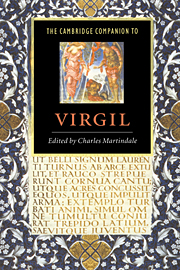Book contents
- Frontmatter
- Contents
- List of illustrations
- List of contributors
- Preface
- 1 Introduction: ‘The classic of all Europe’
- Part 1 Translation and reception
- 2 Virgil in English translation
- 3 Modern receptions and their interpretative implications
- 4 Aspects of Virgil's reception in antiquity
- 5 The Virgil commentary of Servius
- 6 Virgils, from Dante to Milton
- 7 Virgil in art
- Part 2 Genre and poetic career
- Part 3 Contexts of production
- Part 4 Contents and forms
- Dateline compiled by Genevieve Liveley
- List of works cited
- Index
- Plates
5 - The Virgil commentary of Servius
from Part 1 - Translation and reception
Published online by Cambridge University Press: 28 May 2006
- Frontmatter
- Contents
- List of illustrations
- List of contributors
- Preface
- 1 Introduction: ‘The classic of all Europe’
- Part 1 Translation and reception
- 2 Virgil in English translation
- 3 Modern receptions and their interpretative implications
- 4 Aspects of Virgil's reception in antiquity
- 5 The Virgil commentary of Servius
- 6 Virgils, from Dante to Milton
- 7 Virgil in art
- Part 2 Genre and poetic career
- Part 3 Contexts of production
- Part 4 Contents and forms
- Dateline compiled by Genevieve Liveley
- List of works cited
- Index
- Plates
Summary
Servius (called Marius or Maurus Servius Honoratus in MSS from the ninth century onwards) was a grammarian of the fourth century AD, the author of a celebrated commentary on Virgil. This is generally held to be based on a commentary (now lost) by an earlier fourth-century AD commentator, Aelius Donatus (the teacher of St Jerome), and exists in two forms: the longer, known as Servius Auctus, Servius Danielis, DServius, or DS, was first published in 1600 by Pierre Daniel, and is thought to be a seventh- to eighth-century expansion of the shorter form on the basis of material from Donatus' commentary not used by Servius himself. We know little about Servius' life, but he appears as a young man in Macrobius' dialogue the Saturnalia (dramatic date 383-4, but probably composed later in the fifth century) as a respectful follower of the pagan leader Aurelius Symmachus (Sat. 1.2.15).
Servius' commentary comes at the end of a long period of Virgilian commentary, which had begun in the first century BC. The commentary form itself goes back to Hellenistic and earlier Greek scholarship, above all on Homer, and in a sense Servius' work bears the same relationship to Homeric commentary as the Aeneid does to the Iliad and Odyssey. The format is the familiar one of a lemma (one or more words of the text) followed by comments, in the manner of a modern variorum edition: sometimes scholars are named, but more commonly (especially in the shorter version) we have merely expressions like 'some say . . . others . ..' The text is typically seen as raising a 'problem' (quaestio), to which a 'solution' is offered: the methodology goes back to the beginnings of Homeric commentary.
- Type
- Chapter
- Information
- The Cambridge Companion to Virgil , pp. 73 - 78Publisher: Cambridge University PressPrint publication year: 1997
- 14
- Cited by

